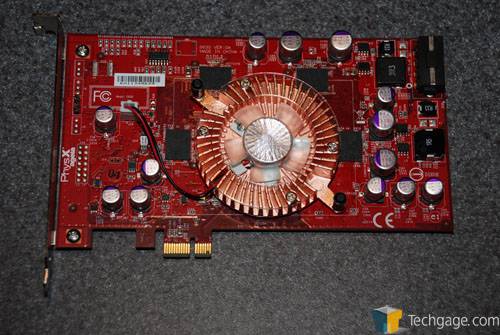- Qualcomm Launches Snapdragon 4 Gen 2 Mobile Platform
- AMD Launches Ryzen PRO 7000 Series Mobile & Desktop Platform
- Intel Launches Sleek Single-Slot Arc Pro A60 Workstation Graphics Card
- NVIDIA Announces Latest Ada Lovelace Additions: GeForce RTX 4060 Ti & RTX 4060
- Maxon Redshift With AMD Radeon GPU Rendering Support Now Available
AGEIA in 2007 – Is This the Year of the PPU?

It’s been over nine months since we’ve last taken a hard look at what AGEIAs been up to, but we are about to catch up. We are looking into what they’ve been up to and also what’s on slate for the coming year.
Page 1 – Introduction
|
|
2006 was quite the year for those of you following the computer enthusiast world. Throughout last year, we saw the materialization of Conroe from Intel as well as their uber powerful Kentsfield CPU which basically mated a pair of Conroes on one chip. AMD had their answer in the form of 4×4 which places a pair of CPUs on one motherboard and while this isn’t exactly original, and certainly not a first, it has its place in the hearts of the enthusiast. Also in 2006, we saw the first DX10 card in NVIDIA’s 8800GTX/GTS.
Last March, we were fortunate enough to cover one of the earliest advances of the year at the GDC. It was at the GDC that Ageia debuted their PhysX card to the public. And it was at the GDC that Ageia showcased the card and what it was capable of. Ageia saw the future of PC games progressing towards more interactivity and their concept was simple: to create an atmosphere that gives the user the ability to interact with virtually anything in the game and in turn, to make the experience as realistic as possible.
There had been physics in games for quite a while and one notable company is Havok. Known for their work on the Half Life 2 series, they have a strong showing with their software driven approach to physics. Ageia saw this, but also saw the eventual limitations in the current hardware. How can a CPU and GPU alone, both being taxed by the games of the time, also calculate object interaction needed to give the games a more lifelike feel? Their approach was a simple one. Let the CPU do what it was intended to do and let the GPU do the same. They set out to build a stand alone card that would handle the in-game physics by itself and they would give the software to make it happen away for free.
At the GDC, we saw some very interesting ideas and an impressive game demo: Cell Factor. With nothing else immediately available, Ageia was waiting on the games. This would be a shared experience for Ageia and the end users who were early adopters and jumped aboard the PhysX train from the start.
Now, let’s fast forward to today. It’s been nearly a year since the PhysX card was unveiled and we are sitting in the exact same spot we have been since the GDC. Because of this, Ageia has taken quite a bit of heat from the press and we at Techgage haven’t exactly been proclaiming the virtues of the PhysX hardware. By now, we have all read the reviews. We know of initial performance drop in games when PhysX is enabled but thankfully this was an issue that Ageia corrected quickly. We have also read about how the card is overpriced for the additional “wow” that it adds to games. And keeping that in mind, there really haven’t been that many games to add any wow to.
Another concern of Ageia, at least initially, was the news that ATI and NVIDIA both had plans to address the handling of game physics. They claimed that this could be done by existing hardware that power users might have lying around. This would be made possible by the use of a third, less powerful graphics card in the place of the PhysX card. Until recently however, very few motherboards included the three necessary PCI-E slots needed to use three GPUs. This made sense at the time too. How many people upgrade their video cards frequently enough to still have a very capable card just sitting idly? I would be willing to bet that not too many people have such a card lying around.
Since the GDC though, there really hasn’t been much mention of this approach by either camp, making Ageia the only true company to address, and carry out, the issue of computer game physics. If you want this editor’s honest opinion, the announcement from ATI and NVIDIA was nothing more than a knee jerk reaction to steal some of the spotlight away from Ageia. While what they said can be done, there has not been any really progression of this technology since. Needless to say, at this point and time, I don’t see either party endangering Ageia all that much. So with ATI and NVIDIA out of the picture as an immediate threat, I only see two major threats to Ageia and their PhysX approach to PC game physics.
Threat One: Multi-core CPUs
Just a few days ago, Rob took an in depth look at Intel’s “budget” quad core Q6600. In his review, the CPU truly shined in multi-threaded apps. When a program was written to take advantage of processors with more than one core, the benefits of owning such a CPU are evident. Intel has released a small little “game” called Ice Storm Fighters that does a good job showing just how well a program can run when coded to use more than one core. In the demo/game, you have the ability to toggle each core on and off individually. If you scale back to only one core being used, you see a significant drop in frame rates and as you turn more on one by one, the performance of the game scales nicely.
It’s this multi-core technology that I see being Ageia’s largest external threat. Not ATI or NVIDIA but rather, the programmers who could decide to offload the physics onto one core, rather than use the PhysX card.
This can be argued against though by bringing up games such as Alan Wake. This is a game that has an incredible buzz surrounding it. Showcasing DirectX 10, it not only looks great, but does so using as many cores as it can. Developers that take this approach will could use one or two for the primary processing, one solely for enemy AI and still have an extra core to use for physics. At CES, we spoke with Intel for a while about their eight core PC. Using a pair of quad core Xeons on a dual socket server motherboard, the PC proved to be an unrivaled beast. This is what I feel Ageia’s biggest threat is.
Threat Two: Ageia and the Game Developers
Without wanting to sound like a broken record, Ageia truly needs games to sell their technology and their cards. Without quality games, Ageia is doomed to roam “hardware with great potential” purgatory in the PC history books. We have all seen Cell Factor, but it’s a demo. We have all seen Ghost Recon: Advanced War Fighter. Let’s face it, a demo and a game patch won’t exactly drive demand for the PhysX card through the roof. However, there is hope for Ageia in the coming year. They were showing off a few new games at CES this year as well as a closer to completion Cell Factor.
|
|
Support our efforts! With ad revenue at an all-time low for written websites, we're relying more than ever on reader support to help us continue putting so much effort into this type of content. You can support us by becoming a Patron, or by using our Amazon shopping affiliate links listed through our articles. Thanks for your support!





